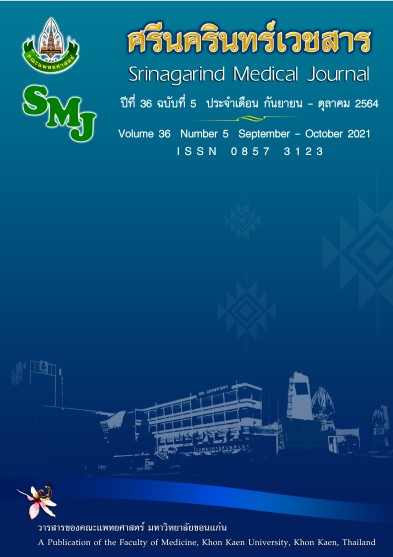The Study of the Satisfaction of Veterinary Students of Khon Kaen University on the Use of Horse Incisor Teeth Models with Augmented Reality (AR) Media in Anatomy Teaching
Keywords:
Horse incisor teeth models; Augmented Reality (AR); Developmental researchAbstract
Background and Objective: The objectives of this study were to study of the satisfaction of veterinary students at Khon Kaen university on the use of Horse incisor teeth models with Augmented Reality (AR) media in anatomy teaching. The important content was studying incisor teeth anatomy of horses to estimation the age for using the horse properly, for trading, for insurance policy and also for disease prognosis. Moreover, the estimate of horse age will be also useful for other animals.
Methods: This study was developmental research. Samples were 24 students from Faculty of Veterinary Medicine, Khon Kaen university. The study instruments were horse incisor teeth models with AR and satisfaction questionnaires. Statistic measurements for data analysis were mean, percentage and standard deviation.
Results: The horse incisor teeth models are main instructional media with AR is supplementary instructional media showed good quality and helped the experimental group to learn and understand content of horse teeth. Result of satisfaction evaluation of horse incisor teeth models was in a highest level with mean of 4.69, percentage of 93.85 and standard deviation 0.46 and result of satisfaction evaluation for AR was also in a highest level with mean of 4.72, percentage of 94.11 and standard deviation 0.45.
Conclusion: The experimental group was able to learn and understand content of horse incisor teeth models with AR well. The horse incisor teeth models with AR can be used as an effective instructional media.
References
บริษัทสยามสปอรต์ ซินดิเคท จำกัด, 2542.
2. ธีระศักดิ์ ตรัยมงคลกุล. เอกสารการสอน รายวิชา 502421 อายุรศาสตร์และศัลยศาสตร์ม้า. คณะสัตวแพทยศาสตร์ มหาวิทยาลัยเกษตรศาสตร์ วิทยาเขตกำแพงแสน. [สืบค้นเมื่อ 5 เมษายน 2564]สืบค้นจาก http://www.las.vet.kps.ku.ac.th/resource.html, 2563.
3. เรืองวิทย์ นนทะภา. เอกสารการสอนวิชาสื่อและเทคโนโลยีการสอน. กรุงเทพฯ: สถาบันส่งเสริมการสอนวิทยาศาสตร์และเทคโนโลยี, 2551.
4. สุสัณหา ยิ้มแย้ม. การพัฒนาหุ่นจำลองเพื่อฝึกทักษะทางคลินิกของนักศึกษาสาขาวิทยาศาสตร์สุขภาพ. พยาบาลสาร 2559; 2: 142-151.
5. ศิริรัตน์ พริกสี. นวัตกรรมเทคโนโลยีเพื่อการเรียนการสอนเคมี. นิตยสาร สสวท. 2556; 181: 17-18.
6. รักษพล ธนานุวงศ์. สื่อเสริมการเรียนรู้ โลกเสมือนผสมโลกจริง (Augmented Reality)
ชุดการจมและการลอย. นิตยสาร สสวท 2556; 181: 28-31.
7. ปรียสลิล ไชยวุฒิ, เยาวลักษณ์ คุมขวัญ. หุ่นจำลองฝึกทักษะการดูดเสมหะ : นวัตกรรมสื่อการสอนทางการพยาบาล. วารสารพยาบาลกระทรวงสาธารณสุข 2560; 2: 47-59.
8. สุมาลี ชัยเจริญ. การเปลี่ยนแปลงของเทคโนโลยีการสอน. ใน : สุมาลี ชัยเจริญ. เทคโนโลยีการศึกษา : หลักการ ทฤษฎีสู่การปฏิบัติ. พิมพ์ครั้งที่ 2. ขอนแก่น: คลังนานาวิทยา, 2554: 31-48.
9. อรชลิดา พรหมปั้น. การพัฒนาหนังสือเสริมบทเรียนสามมิติด้วยเทคนิคภาพเสมือนผสานโลกจริง เรื่อง อุปกรณ์ที่ใช้ในการเคลื่อนที่ของผู้ป่วยไขสันหลังบาดเจ็บ. วารสารศึกษาศาสตร์ มหาวิทยาลัยนเรศวร 2556; 15(1): 24.
10. วิวัฒน์ มีสุวรรณ. การเรียนรู้ด้วยการสร้างโลกเสมือนผสานโลกจริง. วารสารศึกษาศาสตร์
มหาวิทยาลัยนเรศวร 2554; 13(2): 119-127.




